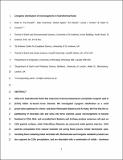Files in this item
Cryogenic silicification of microorganisms in hydrothermal fluids
Item metadata
| dc.contributor.author | Fox-Powell, Mark G. | |
| dc.contributor.author | Channing, Alan | |
| dc.contributor.author | Applin, Daniel | |
| dc.contributor.author | Cloutis, Ed | |
| dc.contributor.author | Preston, Louisa J. | |
| dc.contributor.author | Cousins, Claire R. | |
| dc.date.accessioned | 2019-06-25T23:41:29Z | |
| dc.date.available | 2019-06-25T23:41:29Z | |
| dc.date.issued | 2018-09-15 | |
| dc.identifier | 253451395 | |
| dc.identifier | 3ff5f31b-1ebd-4bf8-a16a-864c73608746 | |
| dc.identifier | 85048962123 | |
| dc.identifier | 000442060600001 | |
| dc.identifier.citation | Fox-Powell , M G , Channing , A , Applin , D , Cloutis , E , Preston , L J & Cousins , C R 2018 , ' Cryogenic silicification of microorganisms in hydrothermal fluids ' , Earth and Planetary Science Letters , vol. 498 , pp. 1-8 . https://doi.org/10.1016/j.epsl.2018.06.026 | en |
| dc.identifier.issn | 0012-821X | |
| dc.identifier.other | RIS: urn:51D4D144A7250CE106ED35E62C0363AD | |
| dc.identifier.other | ORCID: /0000-0002-3954-8079/work/60196590 | |
| dc.identifier.uri | https://hdl.handle.net/10023/17962 | |
| dc.description | his work was supported by The Carnegie Trust (REF: 70335), The Leverhulme Trust (REF: RPG-2016-153), and a Royal Society of Edinburgh research fellowship to CRC. EAC thanks the Canadian Space Agency, the Natural Sciences and Engineering Research Council of Canada, the Canada Foundation for Innovation, the University of Winnipeg, and the Manitoba Research Innovations Fund for supporting the University of Winnipeg's Planetary Spectrophotometer Facility. | en |
| dc.description.abstract | Silica-rich hydrothermal fluids that experience freezing temperatures precipitate cryogenic opal-A (COA) within ice-bound brine channels. We investigated cryogenic silicification as a novel preservation pathway for chemo- and photo-lithotrophic Bacteria and Archaea. We find that the co-partitioning of microbial cells and silica into brine channels causes microorganisms to become fossilised in COA. Rod- and coccoidal-form Bacteria and Archaea produce numerous cell casts on COA particle surfaces, while Chloroflexus filaments are preserved inside particle interiors. COA particles precipitated from natural Icelandic hot spring fluids possess similar biomorphic casts, including those containing intact microbial cells. Biomolecules and inorganic metabolic products are also captured by COA precipitation, and are detectable with a combination of visible – shortwave infrared reflectance, FTIR, and Raman spectroscopy. We identify cryogenic silicification as a newly described mechanism by which microbial biosignatures can be preserved within silica-rich hydrothermal environments. This work has implications for the interpretation of biosignatures in relic hydrothermal settings, and for life-detection on Mars and Enceladus, where opaline silica indicative of hydrothermal activity has been detected, and freezing surface conditions predominate. | |
| dc.format.extent | 8 | |
| dc.format.extent | 981992 | |
| dc.language.iso | eng | |
| dc.relation.ispartof | Earth and Planetary Science Letters | en |
| dc.subject | Cryogenic opal-A | en |
| dc.subject | Silicification | en |
| dc.subject | Microfossils | en |
| dc.subject | Biosignatures | en |
| dc.subject | Hydrothermal | en |
| dc.subject | G Geography (General) | en |
| dc.subject | GE Environmental Sciences | en |
| dc.subject | NDAS | en |
| dc.subject.lcc | G1 | en |
| dc.subject.lcc | GE | en |
| dc.title | Cryogenic silicification of microorganisms in hydrothermal fluids | en |
| dc.type | Journal article | en |
| dc.contributor.sponsor | Carnegie Trust | en |
| dc.contributor.sponsor | The Leverhulme Trust | en |
| dc.contributor.sponsor | The Royal Society of Edinburgh | en |
| dc.contributor.institution | University of St Andrews. School of Earth & Environmental Sciences | en |
| dc.contributor.institution | University of St Andrews. St Andrews Centre for Exoplanet Science | en |
| dc.identifier.doi | 10.1016/j.epsl.2018.06.026 | |
| dc.description.status | Peer reviewed | en |
| dc.date.embargoedUntil | 2019-06-26 | |
| dc.identifier.grantnumber | 70335 | en |
| dc.identifier.grantnumber | RPG-2016-153 | en |
| dc.identifier.grantnumber | en |
This item appears in the following Collection(s)
Items in the St Andrews Research Repository are protected by copyright, with all rights reserved, unless otherwise indicated.

